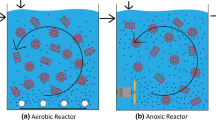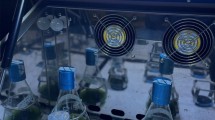Abstract
Gradients of glucose in time and space are shown in a 30 m3 cultivation of Saccharomyces cerevisiae grown in minimal medium to a cell density of 20 gl−1. The fed-batch concept was used with glucose as the limiting component which was fed continuously to the process. As the mean glucose concentration declined throughout the process, the level of glucose was at all times different in three sampling ports (bottom/middle/top) of the reactor. These gradients were furthermore shown to depend on the feed position. This means that if the feed was supplied in the relatively stagnant mixing zone above the top impeller, the gradients were more pronounced than by feed in the well mixed bottom impeller zone. A rapid sampling system was constructed, and continuous glucose samples of every 0.15 s were analysed from a point of the reactor. Fifty samples were collected with this system, but the amount and frequency is possible to change. The results of these series show a variance of the glucose concentration where at one stage, a peak appeared of a relative difference in concentration of 40 mgl−1. The pattern of these rapid glucose fluctuations was shown to depend on the turbulence level at the location of the feed. It was shown, that the fluctuations were more pronounced when the feed was localised in a relatively stagnant area than in the well-mixed impeller area, where the deviation from the mean was negligible. The fluid flow, in the impeller (gassed and ungassed) and bulk area (ungassed) of the reactor, was characterised by turbulence measurements using thermal anemometry. These types of areas resembles well the different areas of sampling as mentioned above. The turbulent frequencies in these areas were in the range of 10−1 to 104 Hz with the highest amplitudes at low frequencies. The spectra depicts a uniform time scale for all zones, especially at the low frequencies. The dominance of low frequency, high amplitude flow variations and the observed short-time oscillations in substrate concentration support the hypothesis of substrate transport over fairly long distances without substantial mixing both in the impeller, but especially, in the bulk zone of the reactor.
Simulations with an integrated CFD and biokinetic model were performed. The predictions of the glucose gradients of this model were compared to measurements.
Similar content being viewed by others
References
Manfredini, R.;Cavallera, V.;Marini, L.;Donati, G.: Mixing and oxygen transfer in conventional stirred fermentors, Biotechnol. Bioeng., 25 (1983) pp. 3115–3131
Steel, R.;Maxon, W.D.: Dissolved oxygen measurements in pilot and production scale novobiocin fermentations, Biotechnol. Bioeng., 8 (1965) pp. 97–108
Carilli, A.;Chain, E.B.;Gualandi, G.;Morisi, G.: Aeration studies: III Continuous measurement of dissolved oxygen during fermentation in large fermenters, Sci. Repts. 1st. Super., Sanitá, 1 (1961), pp. 177–189
Oosterhius, N.M.G.;Kossen, N.W.F.: Dissolved oxygen concentration profiles in a production scale bioreactor, Biotechnol. Bioeng., 26 (1984) p. 546
Brooks, J.D.;Meers, J.L.: The effect of discontinuous methanol addition on the growth of a carbon-limited Pseudomonas culture, J. Gen. Microbiol., 77 (1973) pp. 513–519
Burmester, S.S.; Rielly, C.D.; Edwards, M.F.: The mixing of miscible liquids with large differences in density and viscosity, 7th European Conf. on Mixing, Koninklijke Vlaamse Ingenieursvereniging vzw., 1991, pp. 9–16
Noorman, H.; Hjertager, B.H.; Morud, K.; Trägårdh, C.; Enfors, S.-O.; Larsson, G.; Törnkvist, M.: Measurement and computational fluid dynamics simulation of Saccharomyces cerevisiae production in a 30 m3 stirred reactor, Proc. Bioreactor Performance Symp., Helsingör Denmark, ed. Mortensen, Noorman, The Biotechnology Research Foundation, 1993
George, S.;Larsson, G.;Enfors, S.-O.: Short term kinetics of aerobic ethanol production by Saccharomyces cerevisiae, Bioproc. Eng. 9 (1993) 249–257
Larsson, G.; Törnkvist M.: Sampling and analysis for evaluation of extracellular low nutrient concentrations during suspension cultivation of microorganisms, Manuscript for publication, 1995
Larsson, G.: Use of microorganisms to predict and control the bioreactor performance, PhD thesis, KTH, Stockholm 1990
Patankar, S.V.: Numerical heat transfer and fluid flow, Hemisphere Publ. Co., Washington 1980
Trägårdh, C.: A hydrodynamic model for the simulation of an aerated agitated fed-batch fermenter, In: 2nd Internat. Conf. Bioreactor Fluid Dynamics, Ed. R. King, Elsevier Appl. Science Publ., London 1988
Yee, L.;Blanch, H.W.: Recombinant protein expression in high cell density fed-batch cultures of Escherichia coli, Bio/Technology, 10 (1992) 1550–1556
Koch, A.L.: The adaptive response of Escherichia coli to a feast and famine existence, Adv. in microbial physiology, 6 (1971) 147–217
Barresi, A.A.;Kuzmanic, N.;Baldi, G.: Continuous sampling of a slurry from a stirred vessel: Analysis of the sampling frequency and affecting parameters, Proc. Eighth European Conf. on Mixing, pp 17–24, 1994, Institution of Chemical Eng., Rugby, UK
Author information
Authors and Affiliations
Additional information
This project was supported by a grant from the Nordic Programme on Bioprocess Engineering under the auspices of NI, the Nordic Fund for Technology and Industrial Development and NUTEK, The Swedish Board for Technical and Industrial Development. This investigation was possible to perform due to the support from Statoil Biosentrum in Stavanger, Norway, that provided their pilot plant. Especially the cooperation with Lars Aasberg and Andreas Rag is greatly acknowledged.
Rights and permissions
About this article
Cite this article
Larsson, G., Törnkvist, M., Wernersson, E.S. et al. Substrate gradients in bioreactors: origin and consequences. Bioprocess Engineering 14, 281–289 (1996). https://doi.org/10.1007/BF00369471
Received:
Issue Date:
DOI: https://doi.org/10.1007/BF00369471




